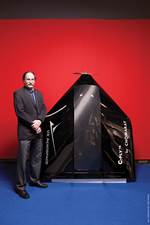A UAV fueled by CNG?
Developed for manned flight, the VX-1 KittyHawk, designed by VX Aerospace (Morgantown, N.C.,) has received more recent attention as a unmanned aerial vehicle (UAV) powered by compressed natural gas.
Originally developed for manned flight in light aviation, the VX-1 KittyHawk has received more recent attention as a long-range, fuel-efficient unmanned aerial vehicle (UAV). “There is nothing like it flying today,” claims Bob Skillen, the founder and chief engineer at VX Aerospace (Morgantown, N.C.).
The plan for both markets is to power the VX-1 KittyHawk with compressed natural gas (CNG). Skillen relates that Aviat Aircraft (Avton, Wyo.) generated a lot of press for its Husky CNG-fueled model at the EAA AirVenture 2013 show in Oshkosh, Wis.
“The tank hung below the belly and the aircraft achieved 80 to 90 mph, burning only 8 to 9 gal/hr,” Skillen recalls. “A full-scale KittyHawk can accommodate CNG tanks without any aerodynamic compromise or cockpit modifications.” CNG is currently one-third the cost of aviation fuel, which the U.S. government would like to see phased out anyway, because it contains lead. With CNG at $2/gal, Skillen projects the KittyHawk can fly two occupants at 140 mph (2 miles/min) with a fuel cost of $.08/mile. “Currently, most light aircraft have a fuel cost of $.20 to $.30/mile,” he notes, “So the KittyHawk would reduce that by a factor of three, but also cut emissions by up to 40 percent.”
This article is a sidebar to a feature article titled "VX Aerospace: Small company, big performance." To read this article, click on its title under "Editor's Picks."
Related Content
-
Combining multifunctional thermoplastic composites, additive manufacturing for next-gen airframe structures
The DOMMINIO project combines AFP with 3D printed gyroid cores, embedded SHM sensors and smart materials for induction-driven disassembly of parts at end of life.
-
Next-generation airship design enabled by modern composites
LTA Research’s proof-of-concept Pathfinder 1 modernizes a fully rigid airship design with a largely carbon fiber composite frame. R&D has already begun on higher volume, more automated manufacturing for the future.
-
Manufacturing the MFFD thermoplastic composite fuselage
Demonstrator’s upper, lower shells and assembly prove materials and new processes for lighter, cheaper and more sustainable high-rate future aircraft.













